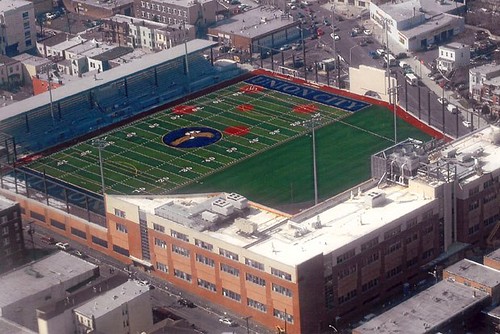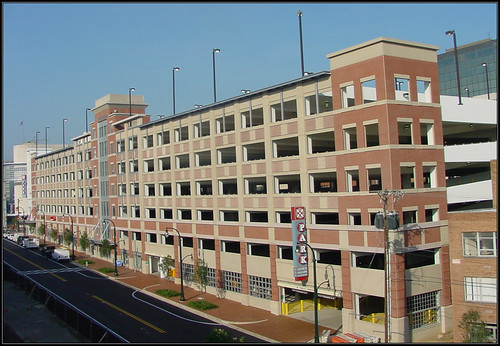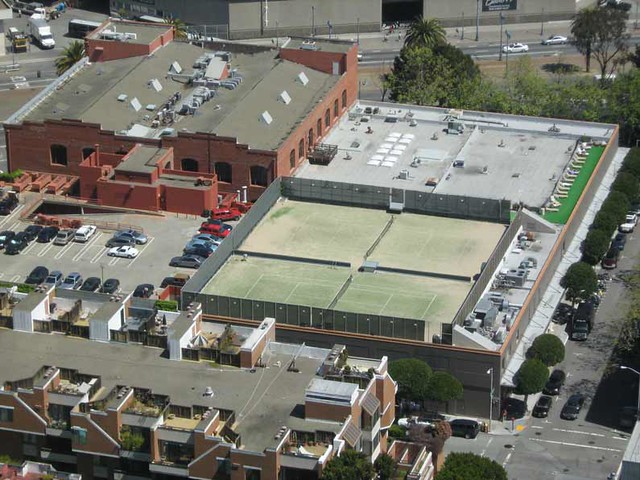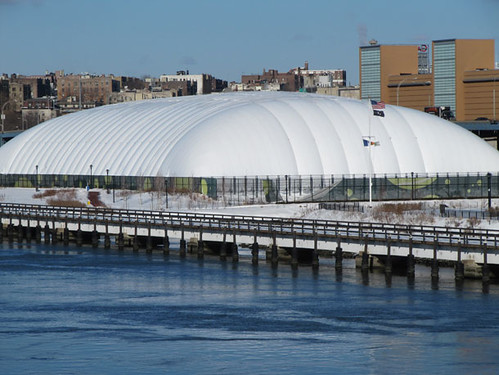Creating the Silver Spring/Montgomery County Arena and Recreation Center (+ and a roof-top athletic field?)
This blog entry expands on item #11, "Creating the Silver Spring/Montgomery County Arena and Recreation Center" from PL #5: Creating a Silver Spring "Sustainable Mobility District" | Part 3: Program items 10-18" as part of this series:
-- Setting the stage for the Purple Line light rail line to be an overwhelming success: Part 1 | simultaneously introduce improvements to other elements of the transit network
-- Part 2 | the program (macro changes)
-- Part 3 | influences
-- Part 4 | Making over New Carrollton as a transit-centric urban center and Prince George's County's "New Downtown"
-- PL #5: Creating a Silver Spring "Sustainable Mobility District"
- Part 1: Setting the stage
- Part 2: Program items 1- 9
- Part 3: Program items 10-18
- Part 4: Conclusion
- Map for the Silver Spring Sustainable Mobility District
- (Big Hairy) Projects Action Plan(s) as an element of Comprehensive/Master Plans
- "Creating the Silver Spring/Montgomery County Arena and Recreation Center"
-- Part 6 | Creating a transportation development authority in Montgomery and Prince George's County to effectuate placemaking, retail development, and housing programs in association with the Purple Line (to come)
-- Part 7 | Using the Purple Line to rebrand Montgomery and Prince George's Counties as Design Forward (to come)
=====
Montgomery County has proposed creating an arena in the Silver Spring Triangle ("Montgomery eyes 5,000-seat sports arena for downtown Silver Spring," Washington Post).
The article describes the preferred program:
The facility would be built either atop, or in place of, two county parking garages that straddle Bonifant Street east of the Silver Spring Metro station. The garages, which together have 1,772 spaces, are a prime parking spot for Red Line riders and people who work in downtown Silver Spring, a major job center.-- REQUEST FOR DEVELOPMENT PROPOSALS For Public Parking Garage 5-55, 1100 and 1101 Bonifant Drive, Silver Spring, Maryland, Montgomery County Department of Transportation
The arena must be designed to serve as “the home of one or more minor league sports teams, with a semi-professional hockey organization as the preferred anchor tenant,” the request says. It also must be able to host high school, amateur and college sporting events, serve as a live entertainment venue, and provide space for exhibits and conventions.
There are plenty of concert facilities in DC especially with some in the suburbs, and a "small" concert hall in Silver Spring, the Fillmore, already, run by the nation's largest "chain" of concert facilities, Live Nation. Montgomery County has a well respected concert hall for classical music, Strathmore, on Rockville Pike.
IMP, a local firm that is able to compete with national circuits, is opening a new facility on the DC waterfront ("Foo Fighters to open The Wharf's entertainment venue," Washington Business Journal). From the article:
The $60 million concert hall, to be managed by 9:30 Club owner and entertainment company I.M.P. Inc., is The Wharf’s entertainment anchor. ... The Anthem can be configured for anywhere from 2,500 to 6,000 attendees, with a variety of seating and general admission and standing-room configurations. I.M.P. is using a movable stage and backdrops similar to the setup at 9:30 Club to accommodate shows of different sizes.The County released an RFP for an arena but didn't receive responses ("Proposed Silver Spring Arena Fails To Generate Developer Interest," Bethesda Magazine). I believe that the expectation that the private sector would want to take this on without significant subsidy is unrealistic, given the economic and use conditions presented.
That doesn't mean creating a public arena isn't important and worth doing, it is.
What it means is that Montgomery County needs to be particularly creative in forging a forward path to realization.
And such a facility should achieve multiple goals and objectives while doing so. For example, why not ensure that with its creation, an urban recreation center facility for a neighborhood is also included?
The district doesn't have a public recreation center, although there is a recreation center, Falcon Hall, at Montgomery College and a YMCA near the Beltway, a couple miles outside the Triangle. Otherwise, Montgomery County has an extensive array of recreation centers, run by the Executive branch agency, the Department of Recreation.
Note that most urban districts in the metropolitan area seem to lack a recreation-community center and it is an opportunity for Montgomery County to demonstrate better practice.
The original idea was to build an arena in place of some aged parking facilities. That's still a decent idea, but I recommend a bigger, bolder (and more expensive) project.
1. Build more than an arena, build a multi-purpose facility, including a recreation center.
Montgomery County is more aware of the possibilities presented by co-locating facilities run by different agencies as discussed in a report commissioned by the county a couple years ago:
-- Colocation White Paper, Montgomery County Department of Planning, MNCPPC
Montgomery College's recreation center at the Takoma Park-Silver Spring campus is obsolete and its replacement is one of the items within a current MC campus planning process.
Montgomery County's Department of Recreation has great, multi-purpose recreation centers but they are not always well located in terms of achieving the best possible economic and community revitalization objectives. There is not a county recreation center within the Silver Spring district.
There are a number of examples of creative co-location. The Idea Store in London's Tower Hamlets borough is a combination library-adult learning/workforce center, located in highly accessible areas rather than in poorly located de-accessioned buildings.
Another is the multi-purpose Drumbrae Library and Community Hub in Scotland ("Work begins on Drumbrae's new library, day care and youth cafe," Guardian). It has a library, teen center, senior programs, and local government facilities.
The Bizkaia Arena for Bilbao's professional basketball team includes a community recreation center with a pool and other facilities. Community members have access to the arena "gym" when not in use by the team (ACXT Architects, Bilbao Arena and Sports center, Archello).
The Kettler IcePlex in Arlington is a practice facility for the Washington Capitals hockey team, which is also used for college and high school hockey teams.
-- The Kettler Capitals Iceplex: A Creative Partnership, Arlington Economic Development
2. Convene a group of public and private partners to develop a wide ranging program of events and a process for implementation, to realize both an arena and a recreation center.
One of my lines is that an RFP isn't a plan, it's a hope that a respondent will come up with a project that you can live with. Without a plan, it's difficult to shape the best possible outcome, especially when the conditions aren't particularly favorable.
I'd recommend bringing together the Montgomery County Department of Recreation, the Montgomery County Parks Department (which is part of a separate agency), the Montgomery division of the Maryland National Capital Park and Planning Commission), Montgomery College, a private music and events firm, Montgomery County Public Schools, and some professional and/or semi-professional sports team partners.
Only by developing a robust schedule of use may it be possible to build an arena facility that can be financially successful. Success defined as (1) not losing much money; (2) meeting various community and public service needs; (3) with such a facility located within the county.
3. Montgomery College as a lead partner for a recreation center and for the arena.
As mentioned, Montgomery College's Falcon Hall is obsolete. The 39,000 s.f. building was constructed in 1978, and includes a gym, pool, fitness areas, locker rooms, classrooms and offices.
While it is rare, some colleges have created facilities shared with localities. The most prominent example is how the San Jose Central Library is co-located with the central library for San Jose State University, and residents can check out books and use the facilities of the college library.
The concept here is to develop the recreation center use jointly with Montgomery College to create a recreation facility and an arena that can simultaneously serve the college and the community.
For marketing and student development purposes, it may be worth it for Montgomery College to develop a more wide ranging community college team sports program as an anchoring use for the arena. Excepting football, the school has teams in major sports--basketball, soccer, and track for both women and men, and a women's volleyball team, already.
-- Montgomery College Athletics webpage
The College has successful cricket and chess teams operating as clubs. Other community colleges have successful basketball and sometimes football programs, and relationships with four year colleges so that athletes can transfer.
Sports can be an effective way to reach students and forge for them an upward path ("Colleges Like Sarah Lawrence Are Putting Poets in Motion," New York Times).
The New York Times recently featured a long piece on such a basketball program at the Manhattan campus of Berkeley College, a for-profit school ("How a 'Second Chance' College Produced the Team to Beat"). From the article:
But current and former players say their team’s success transcends basketball. They describe the program’s founder and coach, Chris Christiansen, 64, as a father figure who recruits young men who have often struggled elsewhere and helps them thrive in the classroom — and long after they leave Berkeley.-- Athletics in Community Colleges, Community College Review
I call Berkeley ‘the second chance school,’” Hector Navarro, a former player, recently said. “They take kids who have no hope and give them some.”
-- The Flutie Effect: How Athletic Success Boosts College Applications," Forbes Magazine
-- New Directions for Community Colleges, Volume 2009, Issue 147. Special Issue: Student Athletes and Athletics
4. Urban recreation center concept.
As already mentioned, the Montgomery County Department of Recreation runs high quality multi-program recreation centers. Working with the Parks Department (a separate agency and Montgomery College, a robust program for an urban recreation center can be developed, ideally incorporating broader community-serving elements as well, as a County function.
A recreation center isn't novel, it's just that as "downtowns" have become mixed use centers adding housing to the typical mix of commercial, retail, and civic functions, parks planning processes haven't caught up, and typically community recreation centers haven't been created within such districts.
Although, private fitness facilities and sometimes "legacy" YMCA/YWCA/YMHA/JCC facilities may exist--but increasingly have a difficult time being funded ("A new day: YMCA merger and revived programs breathe new life into Melrose facility, where membership dipped after scandal," Boston Globe; "Downtown YMCA to close amid rising competition from upscale gyms," Washington Post; "Downtown YWCA: closing," Washington City Paper).
Typically private fitness facilities have limited facilities, and not usually large gyms or pools, although sometimes special facilities not typically available in public facilities can be offered ("Eastbanc's Membership-Free Squash Facility Opening In DC," Bisnow).
Creating a "Downtown Silver Spring" recreation center is an opportunity to address that general omission, including gym facilities, a pool, indoor track, and other facilities.
-- "Provision of public services and recreational centers," 2009 blog entry
Besides Montgomery County's own experience with recreation centers, other examples of multifaceted recreation-community center facilities that can be used to create an even better model.
YMCA-Marblehead, Massachusetts. Seeing this article from the Boston Globe, albeit about a private facility, the YMCA in Marblehead, Massachusetts, shows the value of robust thinking and planning ("New YMCA dazzles and delights with bells, whistles, and ballet"). The new YMCA has a climbing wall, a wi-fi cafe, and ballet studios, among other facilities. Most capital improvement projects are generational--designed to last at least 30 years without significant change. So having the right planning process upfront is crucial to doing it right.
The just opened York Recreation Centre in Toronto ("A place out of no place: the new York Recreation Centre knits the city together by filling a gap: Already more than 10,000 people have signed up to use the centre which has been years in the making," Toronto Star) as another model. It's a multi-faceted facility that is well located in the center of an intensifying suburban town center.
The York Centre offers some lessons in using public facilities to strengthen the sense of place, to leverage other public investments, such as in transit, fostering complementary development, and being located at the center of things rather than in peripheral locations. From the article:
Though a former “no place,” the site really is in the middle of things: at least three neighbourhoods surround it, more depending on how you define neighbourhood boundaries. It will also be a short walk away from the Mt. Dennis station on the Eglinton Crosstown LRT line. Currently under construction on the northwest side of the intersection, the station will be incorporated into the historic Kodak building there. ...I like the example of the Pounds Healthy Living Centre in Hampshire County, UK, although Montgomery County's recreation centers seem to have a similar set of facilities, based on my site visit to the recreation center in Long Branch, which is located next to the Long Branch Library.
Though Eglinton and Black Creek will remain big and busy roads, car scaled rather than human, the centre will help knit the city together by filling in a gap. ...
Fenech describes the centre as a Swiss army knife: one building that does many things. During consultation the community said they also wanted a track, a pool gallery so parents could watch their kids swim, a dance studio and a music room. Change rooms are universal, meaning they are gender-neutral and have individual cubicles. There is light throughout, and the cars alternately speeding or idling on Black Creek are visible to people using the facilities, but the folks in those cars can also see all the action inside as the gym, pool and exercise room are lined with windows.
“You want to attract participants,” says Fenech of their open and “playful” design. “Centres like this used to be just a blank box. You can’t market and maximize participation if people can’t see in.”
According to the report, CREATIVE RETURNS: The Economic and Social Impact of Cultural Investments in Hampshire and the Isle of Wight, the Pounds Centre includes:
a branch library; Portsmouth City Council housing office; fully-equipped gym; sports halls; a ceramics workshop; workshop rooms; meeting rooms; incubation units for small businesses; a crèche; youth centre, community garden and a café. It is next to the newly built John Pounds Medical Centre and opposite the Portsea Venture Playground, a facility for the under-11s. Run by a Community Trust, the Centre aims to provide low-cost, accessible activities, primarily for the local population, that all fall under the broad theme of ‘healthy living’.Arlington County, Virginia has an extensive co-location program. The Thomas Jefferson Middle School is combined with a Community and Fitness Center with fitness facilities, arts studios and classrooms, a theater for a resident children's theatre company, and a large exposition hall -- a field house -- capable of supporting large events, track meets, roller derbies, etc. The indoor program of the annual county fair is held in the field house and the parks department schedules regular roller skating programming.
4. Montgomery County Public Schools could be a partner in the arena as a venue for teams and other uses.
Events could be scheduled at the arena facility and separate field house.
5. For profit music and events.
Developing this segment of a total program will be tough. A program that includes some concerts could be doable.
I talked with an music industry insider who thought that the area has plenty of existing facilities and not much in the way of "holes in the market," making the point that "if there were a good business case for this kind of concert facility, private sector firms would have submitted bids. But we didn't."
A local events firm like IMP--which is based in Montgomery County, or national firms like SMG or Live Nation, could handle the management of the facility for concerts and other events.
But they are likely to be willing to do this as a contractor more than as a partner, given the large number of existing facilities across the region, some public or non-profit (Wolf Trap, centers at GMU and UMD, Lisner Auditorium at GWU, Constitution Hall, etc.) and others private (Verizon Center, 9:30 Club, Fillmore, Warner Theatre, etc.).
Having a reputable firm with solid industry connections and experience is key, as the failure of the private management of DC's Lincoln Theatre is proving ("Howard Theatre insiders detail a chaotic operation, with bounced checks and unpaid vendors," Washington Post).
6. Non-profit events.
One of the reasons that MoCo wants an arena is that they resent having to book official events like large high school graduations at facilities in DC. This segment would need great marketing and management too, and nonprofit clients are unlikely to want to pay top dollar for rental fees.
Still, the use of the Silver Spring Civic Building for events as well as the use of the field house at Thomas Jefferson Center in Arlington prove that there could be demand for such a facility, not just for the "arena" but also for a field house (track +) that could be incorporated into the recreation center.
The trick will be charging for the use. Nonprofits with tight budgets don't like to pay a lot of money for space use. Although "subsidizing" use of the facility can be a legitimate public purpose, including "saving money" for other agencies, e.g., MCPS is paying to use Constitution Hall for graduation events, etc.
7. Independent sports teams.
I have zero knowledge of this market segment, but there might be some opportunity, such as with development leagues in basketball, etc. The original RFP specified including a minor league hockey team as part of the program. The key would be to have as part of the management team a consultant with a lot of experience in this industry.
-- Sports Advisory Group
8. Consider developing an athletic field on the roof of one of the Silver Spring parking garages, preferably the Town Square Parking Garage which brackets Ellsworth Avenue, the Silver Spring Civic Building, and Veterans Plaza, as an outdoor field that is another "entertainment" anchor for the district.
Separately from the proposed Arena-Recreation Center building, it might be worth or at the Montgomery College campus. The Rash Field volleyball court in Baltimore is on the roof of a parking structure, while the football stadium at New Jersey's Union City High School is on the roof of the school, because the city is so dense ("In a Poor School District, a Magnificent New School (With Rooftop Stadium," New York Times). From the article:
The stadium covers three acres in the center of one of New Jersey’s poorest school districts, resting on reinforced steel and concrete above two floors of classrooms. ... The total cost of the stadium was about $15 million, district officials said. Stanley M. Sanger, the superintendent, said the stadium had to be built on the roof because there was no open land available.

The high school stadium at Union City High School in New Jersey is on the roof. Photo from MaxPreps.
The Union City facility was built to accommodate football, soccer, and baseball, with seating for 2,200. When not used for baseball, 1,800 additional seats can be set on part of the "outfield."
Such an offering would be a unique element in the entertainment and activity mix presented by Downtown Silver Spring. A feasibility study would have to be performed, but it could be a cool addition to the core.
It seems like the block where Town Square Parking Garage (pictured below) is located would be big enough to accommodate this use. And that would be the ideal location, alongside the pedestrianized Ellsworth Drive and across from the Veterans Plaza and Civic Building.

9. A garage-top tennis facility?
Since we're talking about a robust planning process and a "transformational projects action plan" for Silver Spring, an indoor tennis facility could also be considered, plopped on top of another parking structure. The YMCA Arlington Tennis & Squash Center is an indoor facility with 8 tennis courts and 2 squash courts. But it's "on the ground," not on top of a parking structure.

Tennis courts on top of a building in San Francisco. Photo from High Beach.
Similarly, it might be less expensive to put a "field house" on top of another parking structure rather than to include it in the arena-recreation center footprint.
While the photo above shows a roof top facility open to the elements, I am thinking more of an indoor facility, perhaps one of those "tennis bubbles."

Stadium Tennis Center at Mill Pond Park, Bronx, New York City. Photo: Tennis Grandstand.
According to the "rooftop portfolio" webpage of Classic Turf Company, they have:
worked with both private and public facilities to provide state-of-the-art rooftop sports surfaces including tennis and basketball & tennis courts, bocce ball courts and children’s play areas. We work closely with our clients to developed a customized facility design that meets their specific needs.In any case, roof tops of parking garages are opportunities, as the Kettler IcePlex has already proved.
Labels: cultural planning, music-entertainment, parks and recreation, parks planning, sports and economic development, stadiums/arenas, suburban revitalization, urban design/placemaking



5 Comments:
Scary-- an arena for Virginia Beach, 18,000 person capacity and they hope to land a professional basketball team -- will cost $220 million.
https://pilotonline.com/news/government/big-plans-in-the-works-for-virginia-beach-s-entertainment/article_bd9f6f7c-5eb7-50ce-9623-d7d831dea22e.html
and VB has a separate project for a field house.
https://pilotonline.com/news/government/local/virginia-beach-leaders-want-to-build-a-million-sports-field/article_31074f2e-0cc2-533e-b19a-7cc038f174ff.html
but it's a much different concept than outlined above.
It's expected to cost $40 million.
Anne Arundel County offers Maryland Live Casino no property taxes on a proposed conference center addition in return for the Casino agreeing to providing free access to County-sponsored events such as high school graduation ceremonies.
http://www.capitalgazette.com/maryland_gazette/ph-ac-cn-pilot-proposal-0209-20170208-story.html
https://www.post-gazette.com/business/development/2022/11/01/university-of-pittsburgh-student-recreation-center-planning-commission-approval-nine-story-pitt-site/stories/202211010124
"University of Pittsburgh gets planning approval for 9-story rec center"
Another rooftop used for courts.
Nation's Biggest “Futsal Town” Located on Seoul Department Store Rooftop | Be Korea-savvy
http://koreabizwire.com/nations-biggest-futsal-town-located-on-seoul-department-store-rooftop/104601
Post a Comment
<< Home